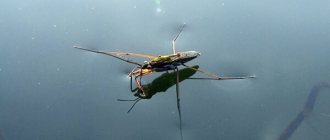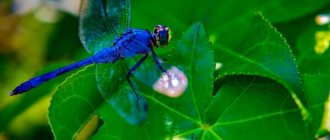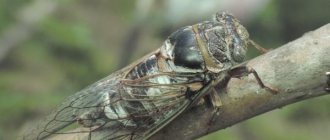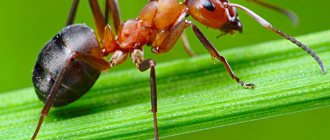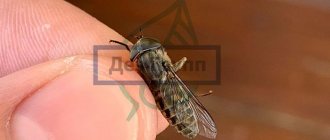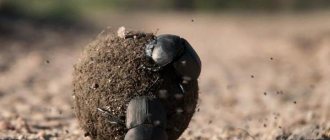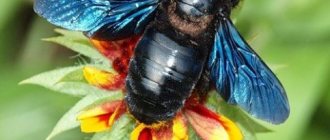Swimming beetle is a collective name for aquatic insects belonging to the order Coleoptera. In nature, there are 4 thousand species, 300 live in Russia. Beetles can fly and swim perfectly. They spend most of their lives in water. They prefer ponds and lakes with standing water. Adult swimmers and their offspring are active predators. They attack fish and fry, tadpoles, mosquito larvae, and mollusks. In fish farming areas, the appearance of a swimming beetle becomes a real disaster.
Morphological description
Swimming beetles (Dytiscidae) are a family of medium and large beetles that live in bodies of water. They are found throughout Europe and Asia; in North America they even inhabit the Arctic territory. Insects choose fresh water bodies with a lot of plants and standing water. These can be ponds, lakes, ditches and deep puddles. The size of the diving beetle, depending on the species, is 2-4.5 cm.
The universal insect can crawl, swim and fly. Not many representatives of the Coleoptera order are endowed with such abilities. On land, swimmers move slowly, waddling from side to side. They push off with the hind limbs, and move with the front and middle limbs.
Description of the swimming beetle
The oval, flat, streamlined body of the beetle is optimally adapted for movement in the water column. The hind legs act as a mechanism for movement. The limbs have well-developed muscles. The flattened tibia and tarsus are covered with two rows of elastic hairs. The swimming beetle's method of movement in water resembles rowing with oars. The hind limbs move simultaneously. Durable bristles on their surface replace paddle blades. The middle legs control the direction of movement - up or down. The forelimbs are not used. The front and middle legs are noticeably shorter than the hind legs.
The body consists of three sections: head, chest, abdomen. The head is fixedly attached to the chest, which passes into the abdomen without a sharp boundary. The color is predominantly dark - green, brown, black. Some species have a light (gray or orange) edging along the body and head. The abdomen consists of 8 segments covered by hard elytra.
The insect's head is wide and flat. There are large eyes on the sides. Each consists of 9 thousand simple eyes, allowing you to distinguish between static and moving objects. Behind the transverse plate of the upper lip is a powerful jaw designed for capturing and chewing prey. The mouthparts are gnawing type. Long segmented antennae are the organ of smell. They are located on the sides of the forehead and consist of 11 bare segments.
How does a swimming beetle breathe?
Swimmers spend most of their lives underwater, but breathe air. Insects need to regularly come to the surface to replenish their oxygen supplies. How does the respiratory system of a swimming beetle work? The flow of air into the body is ensured by special openings - spiracles located on the abdomen. A system of tubes - tracheae - diverges from the spiracles to all parts of the body. There are air sacs in the insect's chest. The abdomen contracts and unclenches rhythmically, creating air movement in the trachea.
The beetle has glands on its body that lubricate the ends of the elytra and abdomen. To renew its air supply, the swimmer puts the end of its abdomen outward. Contractions of the organ allow air to be pumped under the elytra. Larvae also breathe; their body ends in thread-like appendages that serve as spiracles. To inhale a portion of air, the insect emerges every 10 minutes.
Main characteristics
Aquatic beetles mainly live in stagnant ponds and love deep bodies of water with rich wildlife. The swimmer by its nature is a predator , and accordingly, it needs a sufficient amount of live food. But if a number of conditions are met, then it can be successfully kept in an aquarium.
Swimming beetles go through a full development cycle from egg to adult, the length of which can be up to 4 cm. In addition to ponds, swimming beetles live in such reservoirs as:
- lakes,
- big puddles,
- ditches.
In reservoirs they hunt small fish, worms and other living creatures. They do not kill their prey, but eat it alive, tearing off pieces from it.
Males and females can be distinguished by the presence of so-called “plates” on their front legs, thanks to which they hold the females in place during the mating period.
Lifestyle
The swimmer easily floats to the surface of the reservoir, because its body is lighter than water. Descending requires more effort. To stay at the bottom of the reservoir, it needs to cling to a stone or plant. The beetle's forelimbs have special hooks that allow it to attach to any smooth surface. Insects are active at night, they hunt or go in search of a new home. Fauna lovers are interested in whether the swimming beetle flies or not? Adult males and females have well-developed wings. In search of favorable habitats, they fly tens of kilometers.
Before the flight begins, specific preparations take place. The beetle crawls ashore and empties its intestinal contents. It then fills the air sacs on the chest. Having reduced its body weight as much as possible, the swimmer takes off. When searching for bodies of water, it relies on sight. Noticing the shine, the insect dives down. Tactics often fail the beetles; instead of a pond, they end up on glass greenhouses or galvanized roofs. Many travelers die from a strong impact on a hard surface.
During the cold season, many insects hide in cracks or burrow into the soil. Where does the swimming beetle overwinter? Among the many species of insects, there are those that spend the winter in the egg, larval or adult phase. Insects living in Europe are characterized by immersion in diapause of adult beetles. After emerging from the pupa in the fall, the young beetles remain to overwinter in the litter or under the bark. Some of the swimmers return to the reservoir. When there is enough oxygen, they actively swim. Complete freezing of the surface forces the beetles to burrow into the mud and fall asleep until it warms up.
The enemies of swimming beetles are birds, small mammals, and fish. The dark color helps the insects blend in with the bottom rocks. Many parasites live on swimming beetles: nematodes, parasites, and water mites.
How long do swimming beetles live? The lifespan of adults ranges from several months to two to four years. Most beetles live for about 1 year. The shortest life cycle is found in representatives of the species Agabusfuscipennis, common in Europe and the Middle East.
Insect lifestyle
Despite the fact that the beetle can fly, it practically does not leave the reservoir if there is enough food for it. At the same time, it quite often rises to the surface of the water to stock up on oxygen. To do this, the beetle has a special place that is filled with air; it is enough for it to expose the back of its body from the water.
In winter, especially in severe cold conditions. The swimming beetle does not show any activity while in a state of suspended animation. To do this, insects dig special holes in the ground where they wait out the cold.
Nutritional Features
What does the swimming beetle eat? The predator eats any protein food; it does not disdain eating dead fish. Sharp and wide mandibles allow them to attack large prey. A hungry beetle attacks fish or frogs that are 3 times its size. How does he cope with large prey?
He is helped by the rest of the swimmers living in the pond. After the first bite, the victim's blood enters the water. Thanks to their keen sense of smell, predators detect it at a considerable distance. A dozen beetles gather around the fish, tearing off pieces of living prey. In most cases, insects are content with invertebrates and mollusks.
What to eat, lifestyle
The diet of the dung beetle is excrement, carrion, and mushrooms. They prefer to feed on cattle feces and manure - this is where the name comes from. They eat at home, pulling food into their burrow, which is placed at a depth of 15 to 50 cm.
Eating dung beetle
The excrement is rolled into balls of the correct shape. They roll to their place of residence, making incredible efforts. The weight of the food is several times greater than his own. Dung beetles can roll balls on the ground with their front and hind legs.
To prevent food from drying out, the beetles bury it underground, and when they get hungry, they take it out. Often in the process of rolling balls, clashes occur. The winner takes the prize. In hot weather, food protects dung beetles from overheating. The beetle climbs onto the ball, and after a few minutes its body temperature drops several degrees.
The big hard worker is active at night, during the day he hides in a hole or a secluded place, away from the light. Often a dung heap serves as a refuge for him. It determines the location of food by smell, flies through the air or crawls along the ground. During the flight, a heavy hum is created, and the landing is always “rocky”. It just falls to the ground.
In addition to feces, the beetle eats carrion and mushrooms. For this he is called the pasture cleaner. Dung beetles drink water in a special way. In the morning or evening, they spread their wings, droplets of dew collect on them, which gradually roll into the mouth.
Reproduction
Sexual dimorphism of diving beetles is expressed in differences in size (females are larger) and the structure of the fore and middle limbs. In males, the first three segments of the tarsi are expanded. They have suction plates - from tens to hundreds of pieces. They are used to hold the partner during mating. The breeding season of beetles is in spring. The process takes place in water. For females, it can cost their lives. During mating, they are not able to float to the surface and fill the elytra with air.
After fertilization, the females begin laying eggs. The water swimming beetle has large eggs, reaching a length of 5-7 mm. The laying is carried out in the bottom substrate, plant tissue. The number of eggs laid per season is 1000. Using a sharp ovipositor, cuts are made in the stems and leaves into which an oval egg is placed. After 10-12 days, the larvae appear. In cold weather, the development time of the embryo is delayed up to a month.
Information. The clutches of diving beetles are threatened by riders living in the water. These are prestwiches, insects measuring 1 mm. Their offspring parasitize the eggs of beetles and dragonflies. More than 100 riders can develop in one egg.
Larval development
The color of the swimming beetle larva can be yellow, gray, or brown. Often the body is covered with a pattern of dark stripes and spots. Externally, the offspring look like scorpions, not swimmers. From birth, larvae are voracious predators. Their first food is caviar, larvae of caddis flies, dragonflies, and mosquitoes. The head is flattened, the thorax consists of three segments, and the abdomen consists of eight segments. There are 6 simple ocelli on each side of the head. The antennae are thin, 3-segmented in the first instar, and 6-segmented after two moults.
The oral appendages are located transversely. There is no upper lip, but the lower lip is formed by a wide plate with palps along the edges. The strong mandibles are curved in the shape of a sickle, the edges are pointed. They move only in the horizontal plane. The mandibles are connected to the pharynx by channels. The larvae do not have a mouth opening. Food enters through the jaws.
The digestive system of insects is also unusual. The prey is fermented not inside the stomachs, but outside. The larva plunges its mandibles into the body of the victim and injects digestive juice. After a few minutes, the tissues and organs soften. The contents of the prey are absorbed directly into the pharynx. Having finished feeding, the insect cleans the mandibles with its front legs. The larva of the swimming beetle is a tireless and voracious predator; having finished with one victim, it goes in search of the next.
The oblong, wide body tapers to the posterior end, crowned by two cerci. It contains various formations: spines, bristles, scales. Three pairs of long limbs are attached to the thoracic segments. The legs consist of 5 segments. There are swimming hairs on the thighs and lower legs, and the tarsus ends in two claws.
In its development, the larva changes through 3 instars. The last third instar is the longest. At the beginning of autumn, the larva leaves the pond. On the shore, she builds a cradle from the remains of plants and lumps of soil. Pupation occurs in the cradle. The phase lasts about a month. The pupa is white, soft, open-type. After emerging from the pupa, the imago is also soft and light-colored. After a few hours, their cover darkens and hardens.
Natural enemies of the swimming beetle
This insect causes significant damage to fish farms, especially at the initial stage of fish farming, when the beetle can prey on small fish. After the life of this seemingly very small predator, fish farms do not have a large number of young fish. It should be noted that the diving beetle also has its enemies, which regulate its numbers in water bodies. Otherwise, serious measures would have to be taken to combat this natural pest of water bodies. The swimming beetle is hunted by larger predatory fish species, many birds, including seagulls, as well as mammals inhabiting water bodies.
Interesting fact! In case of danger, the swimming beetle secretes a special secretion, which with its aroma scares off those who do not mind eating this predator.
Some living creatures are interested not only in the adult beetle, but also in its larva. It is worth paying attention to the special natural enemy of the larvae of the diving beetle - this is the ichneumon insect. The peculiarity is that the female ichneumon, having found the eggs of the diving beetle, lays her eggs in them, which develop due to the nutrient medium of the beetle eggs. After the wasp larva has eaten all the supplies, it pupates. After some time, an adult insect, the ichneumon ichneumon, emerges from the egg of the swimming beetle.
Therefore, despite the high fertility of this predator, its populations in water bodies are maintained at an optimal level by natural enemies, which prevents it from having a serious impact on the populations of various fish species.
Species of diving beetles
The Latin name for the insects, Dytiscus, comes from the Greek word for “diving.” It accurately characterizes the behavior of the beetle. Among the large family, several interesting species can be distinguished.
Banded swimmer
A common species of swimming beetles, the habitat of which is bodies of water with stagnant or low-flow water. The oval body is black or dark brown. The limbs are orange, as is the edging that runs along the elytra. The adult size is 27-35 mm; a larger subspecies (32-37 mm) is found in the Far East. The male is smaller than the female and has a smooth surface on the elytra. Carnivorous predators attack larvae, fry, tadpoles, and, in the absence of small prey, frogs and fish. They live in Europe, Central Asia and Siberia.
Broad swimmer
The body length of an adult beetle is 35-45 mm. The large, wide beetle is distinguished by its brown or black color with a green tint. The photo shows that a yellow border runs along the edge of the pronotum and elytra of the swimming beetle. The larvae have a long fusiform body and are larger than the imago, growing up to 60-60 mm. Insects inhabit lakes with clear and turbid water. They prefer to keep it close to the shore. They are observed in reservoirs overgrown with sedge, horsetail, cinquefoil, and water lily. The broad swimmer is a rare species. He disappeared in 10 European countries. The beetle is listed in the IUCN Red List.
Information. Swimming beetles have few enemies in the water; large predators do not touch them. Insects have a defense mechanism - when attacked by an enemy, they secrete a white caustic liquid.
Where does Khrushchev live?
Photo: Khrushchev in Russia
The habitat of the Khrushchev is located mainly in the Northern Hemisphere - Europe, Asia, North America (temperate zone, tropics). Their population is least numerous on some islands of Oceania, Africa, South America, where beetles can only be seen in the northern part of the mainland. In the colder regions of the temperate zone there are very few beetles, and not a single species lives in the taiga zone.
As for the habitat, the beetles chose wooded areas with loose sandy and semi-sandy soil. At the same time, they completely avoid clay soils, since it is quite problematic for females to dig tunnels there in order to lay eggs.
Today, entomologists identify 63 species of cockchafers, here are descriptions of the most interesting of them:
- Oriental May Khrushchev (wild chestnut Khrushchev). In this species, sexual dimorphism is most pronounced: females are much smaller in size than males (males - up to 29 mm, females - up to 15 mm). The color of this species is dominated by reddish and brownish shades. The beetle is also distinguished by black antennae. The most common oriental beetle is in Europe and Asia.
- Caucasian Khrushchev is a rather rare species of beetle that lives, oddly enough, in Germany and Austria (western part). The difference from other species is the shorter and more rounded pygidium, as well as the presence of scales on the elytra instead of hairs.
- Western Khrushchev is slightly longer than its eastern counterpart and has a more convex body. Another difference is habits. So, for example, he loves a warmer climate, lives in fields, and not in forests and gardens, and also appears 10-12 days later in the spring, when it becomes thoroughly warmer. His antennae are light brown, not black. It lives mainly in the south of Ukraine (Kherson and Odessa regions, lower reaches of the Dniester River).
Now you know where Khrushchev lives. Let's see what this beetle eats.
Undesirable neighborhood
Having settled in a decorative pond, a predatory beetle attacks decorative fish and other inhabitants. Owners of ponds are faced with a difficult problem: how to get rid of the swimming beetle in the pond? The least labor-intensive way is to have crucian carp, which actively destroy the larvae of the swimming beetle. Another option is to temporarily install a pump or fountain that creates movement of the water mass. The insect prefers stagnant bodies of water, so it will leave its shelter and go in search of a better habitat.
If the above methods do not work, then all that remains is to drain the water, clean and disinfect the bottom. This will destroy the adults and larvae of the beetle. After treatment, water is poured in and new inhabitants are released.
Danger to humans
You can encounter a predatory beetle while swimming in a lake or in your own pool. The insect shows aggression towards humans extremely rarely. The bite is painful, but does not pose a threat to health. The swimming beetle bites in the water if it feels threatened. The pain from the skin puncture remains for several minutes. After some time, the wound swells and a lump may form. The beetles are not poisonous, so there is no allergic reaction.
The victim must be given first aid:
- wash the wound;
- treat with an antiseptic (iodine, hydrogen peroxide);
- apply a bandage;
- apply ice to relieve swelling.
Attention. Often, those who pick it up without the necessary skill get bites from the swimming beetle.
Interesting Facts
There is an opinion that the diving beetle chooses weak and sick inhabitants of the pond as victims for attack, that is, it is, in fact, an orderly. The diving beetle usually does not show hostility towards a person who finds himself in the same water pool. But the bite is very painful even for a person.
The sharp pain associated with the bite may go away after some time, but swelling occurs in the bitten area, completely disappearing after 14-20 days. The wounded area must be washed, treated with disinfectants, bandaged and a cold compress applied.
Most often, beetles show aggressiveness towards those who try to catch them and pick them up. At home, experts do not recommend keeping swimming beetles and ornamental fish in the same aquarium, as the predator will attack them and can seriously injure them.
Sources:
https://givotniymir.ru/plavunec-zhuk-obraz-zhizni-i-sreda-obitaniya-zhuka-plavunca/ https://prusakam.net/zhuk-plavunets/ https://givnost.ru/plavunets-zhuk- nasekomoe-opisanie-osobennosti-vidy-obraz-zhizni-i-sreda-obitaniya-plavuntsa/
Body parts
The swimmer's body consists of three sections. These are the head, chest and abdomen. All sections are motionlessly articulated with each other. All this, combined with the oval shape of the body, makes the beetle an excellent swimmer. The swimmer's head is retracted into the chest, the pectoral segments are fused, smoothly turning into the abdomen.
The head contains mouthparts and sensory organs. The swimming beetle is an active predator. Due to the fact that the mouthparts are directed forward, the insect can grab prey when chasing. The upper lip has the appearance of a transverse plate. Behind it is a pair of remarkably developed jaws that grab and crush the prey. Their ends are pushed forward, like pointed teeth. Behind the upper jaws there is a pair of lower jaws with palps; they are limited on the sides by the oral opening. Below the mouth is the lower lip. Short palps on the jaw and lip are organs of taste and touch.
With the help of their mouthparts, swimmers and some other insects capture, chew and crush prey. That's why they are called gnawing ones.
There are compound eyes on the sides of the head. Each one consists of 9 thousand simple eyes. The fringed swimming beetle, whose body shape is comparable in streamlining and strength to that of a submarine, distinguishes the outlines and size of moving objects. In front of the eyes, the insect has a pair of antennae, which belong to the organs of touch, smell and taste.
The legs and wings are located on the chest segments. Only the first segment can be seen on the back of the beetle. Its upper part - the so-called dorsal shield - is similar in shape to a trapezoid. The remaining segments of the thorax, as well as the abdomen, are covered with hard elytra (modified fore wings), which are protected from above by delicate hind wings. The remaining parts of the swimming beetle's body are hidden behind durable covers.
Stiff fore wings are characteristic of all beetles, which is why they are called Coleoptera. First, the swimmer raises its elytra, moving it slightly to the sides, then spreads its folded wings and only after that takes off. In flight, elytra and wings are as important for an insect as the supporting planes and propeller are for an airplane. On land, the swimming beetle moves rather slowly, while waddling from side to side, pushing off with its hind legs and moving its front legs.
Agile and voracious predator
The diving beetle larva has external digestion. In its sickle-shaped hollow jaws there is a channel through which digestive juice is injected into the body of the prey. It turns out that he is able to dissolve the tissues of the victim, turning them into broth, which the larva feeds on through the same channel in the jaws. The bite of this small and voracious predator is very painful.
The larva of the fringed swimming beetle reaches 6 centimeters in length and 1 cm in width. It breathes, like an adult insect, atmospheric air, barely exposing the tip of its abdomen from the water. The lifespan of the larva is from two to three months; during this period of time it molts once.
Pupation occurs on land. First, the larva makes an earthen cradle. A week later, it begins to pupate, and after another 14-21 days the pupa turns into a beetle. It is initially white in color, with very delicate coats, black eyes and brown legs. Over time, the integument will become hard, and the beetle will take on its usual appearance.
The larvae of the fringed diving beetle live, like adults, in fish ponds. They can cause serious harm because they eat fish fry.
Laying eggs
Immediately after mating has occurred, the female begins to lay eggs. Their length is about 7 millimeters and their diameter is 1.2 mm. One female lays about 1000 eggs per season, a particularly fertile one lays up to 1500. This is possible only with sequential maturation, so the whole process drags on until the end of June. Eggs are laid in plant tissue. For protection, the female cuts them with the ovipositor, however, this does not always save future offspring from parasites. One of the most dangerous enemies for swimming beetles is the prestwichia rider. These parasites lay several dozen of them in each beetle egg. The ichneumon ichneumon larva feeds on the diving beetle's egg, pupating inside it. Young parasites emerging from the dolls mate and then leave the shell. Prestwichia and caraphractus are the only enemies of swimming beetles.
Keeping in an aquarium
To keep a swimming beetle at home, you need to equip it with housing.
The aquarium in which the insect will live should be spacious, about 60 centimeters in height. The swimming beetle is considered one of the largest on Earth (among aquatic invertebrate arthropods). It is imperative to install a filter in the aquarium; one that is not intended for air supply is also suitable. The swimming beetle (we have already figured out what the predator feeds on) will not die from lack of oxygen, since at any moment it can float to the surface and replenish its air supply.
It is advisable to keep this insect in a closed aquarium, because it flies wonderfully. Once again, I would like to note that you should not keep a swimming beetle with fish, because you have decided to acquire a predator.



